
AI and Digital Marketing: How Our Agency Uses AI
AI is getting better every day, but can it handle digital marketing on its own? We break down the pros and cons of AI in marketing and how we use it. …
Google is no stranger to changing the way that people search and find information. As a business, Google is constantly finding new ways to improve the search experience so that users quickly find what they need when they need it. The problem for marketers is that Google’s latest AI-driven iteration of Search Results may make it harder for people to find their businesses.
Search Generative Experience (SGE) is the latest experimental update that businesses need to navigate. Originally launched in May 2023, what was once a small experiment has evolved into a fundamental shift toward having artificial intelligence generate answers for people.
While there are plenty of reasons why marketers should embrace AI, it’s no surprise that there is plenty of apprehension about how SGE will impact business’ organic and paid efforts. People haven’t talked this much about AI since Allen Iverson stepped over Ty Lue. That concern leads to a lot of questions:
The good news is that we can help answer most of these questions – you’re on your own about the robot overlords. There’s plenty to learn about the new world of Search, so let’s break down how SGE works and what it means for your business.
Before we go too deep into AI, let’s start off with the basics. Generative Artificial Intelligence (Generative AI) is a subset of artificial intelligence that produces new content for users. Unlike traditional AI, generative AI tools aren’t based on rule-based algorithms to perform specific functions or recognize patterns. Generative models can instead learn from existing artifacts and crawl data – which includes your website – to create just about whatever you need, including:
While generative AI is a hot topic these days, early examples of this technology date back to the 1950s and ‘60s. Markov Chain, a statistical model used to generate new data sequences, is known as one of the first examples of generative AI, but the prospects for machine learning really took off in the 1990s and 2000s when digital data and advanced hardware became accessible.
These days, generative AI tools like ChatGPT, DALL-E, and Bard all use machine learning to create just about whatever new content that their users want. These tools have already had a profound impact by giving people the ability to:
And those are just the current possibilities! As you may expect, the prospects of generative AI are both exciting and frightening depending on who you ask. For businesses dependent on digital marketing, it’s a mix of both, especially with Google overhauling Search to take advantage of AI.
Search Generative Experience (SGE) is Google’s AI-driven process of delivering search results. That’s a fancy, official way of saying that Google’s AI will quickly crawl existing websites and other sources to create customized search engine results page (SERP) that displays AI-generated answers for users.
Sounds great, right? The problem for businesses is that the goal of SGE is to give users all the information they need right on the same page instead of directing users to other sites, including yours. The days of Search Results simply organizing and presenting web pages are gone in favor of completing the information gathering cycle all in one tab.
While SGE was originally available through a Google Labs waitlist, Google aggressively pushed out the new search experience over the course of the year. A whopping 77.8% of searches had an SGE result by November 2023, and that number has only grown since then. SGE is still technically in beta, but it’s safe to presume that it’s only a matter of time before it’s made official.
As we’ve said, generative AI powers SGE’s results. Google specifically uses a large language model (LLM) called Pathways Language Model 2 (PaLM 2) to gather, organize, and translate information in user-friendly responses that people can see right on their SERP.
Once a person searches something, SGE will find and present information at the top of within fractions of a second. The exact presentation of what the user sees will depend on how SGE displays that information. It’s not completely clear why Google has different display states for searches, but users can experience SGE in one of three general variants:
Data released by enterprise SEO platform BrightEdge in December 2023 found that SGE displayed collapsed results 16% of the time. This abbreviated autoload shows part of the SGE and prompts user to click a “show more” button to open the rest of the AI-generated result. Aside from a full autoload, this state takes up the most space.
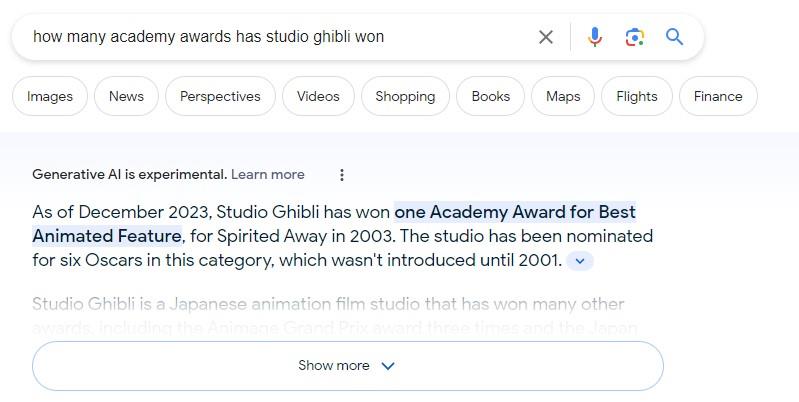
According to research, users received an opt-in result 68% of the time. This result is much less intrusive than other states, as it only generates a prompt at the top of the page asking if users would like to generate and display an SGE for their query. The rest of the page is a traditional SERP.

Sometimes even our robot overlords don’t have anything special for us. Research shows that roughly 15% of searches don’t trigger an SGE display, meaning that these SERPs will only show site listings, rich snippets, and everything else that we’ve grown used to seeing. This display tends to be more closely associated with straightforward searches for products, services, or specific things than queries looking for general information.
Regardless of whether users receive information in a collapsed or opt-in state, there are a few standard features that users can expect. SGE results include a few baseline components generated by AI:
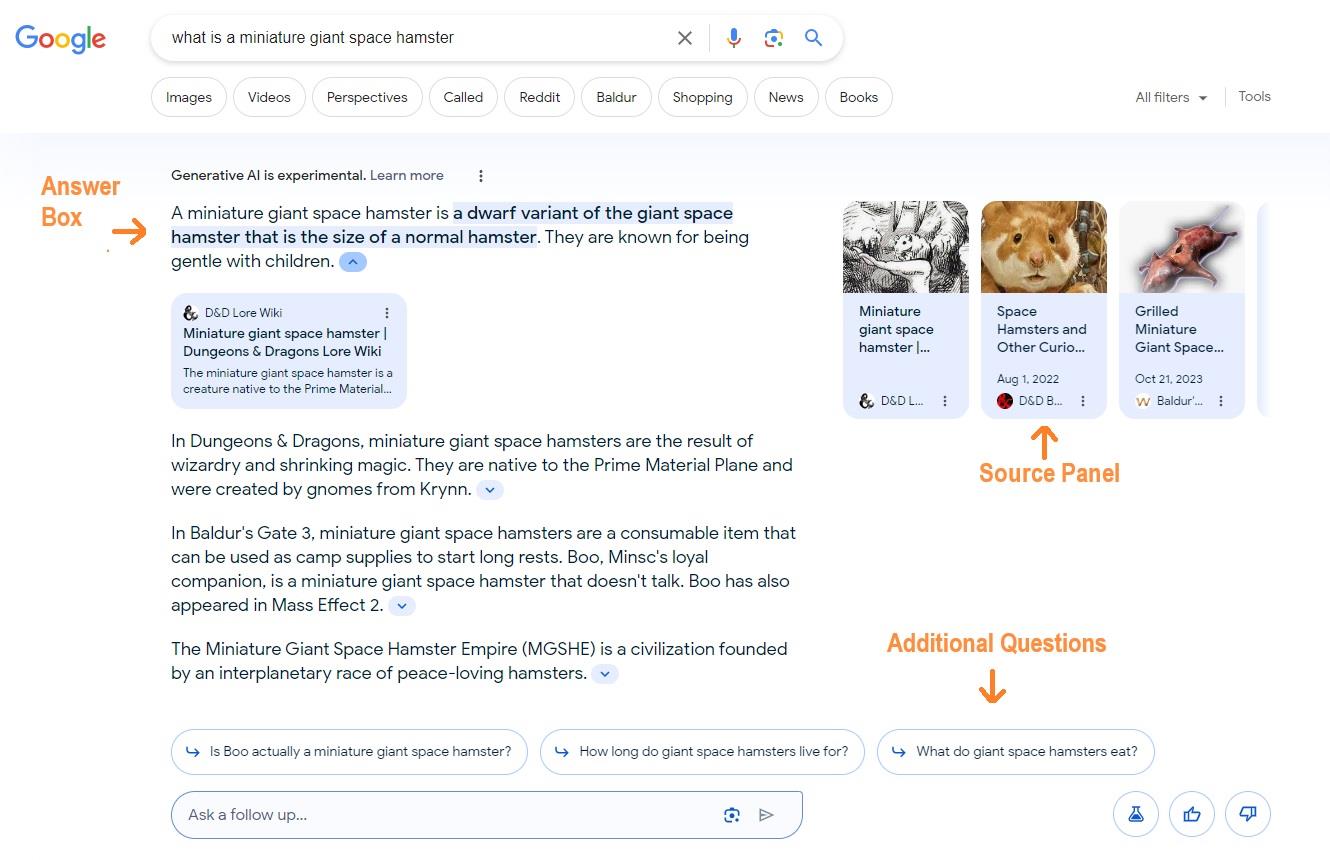
Outside of elements, there is a lot of variety in the way that SGE displays results. SGE uses multiple content formats to try and customize how information is displayed based on the intent of someone’s search. Some of the more notable SGE modules include:
As you probably guessed, the list module presents users with information in list form. Answers can be ordered or unordered to help answer queries with multiple answers. The exact presentation of lists come in multiple forms, including:
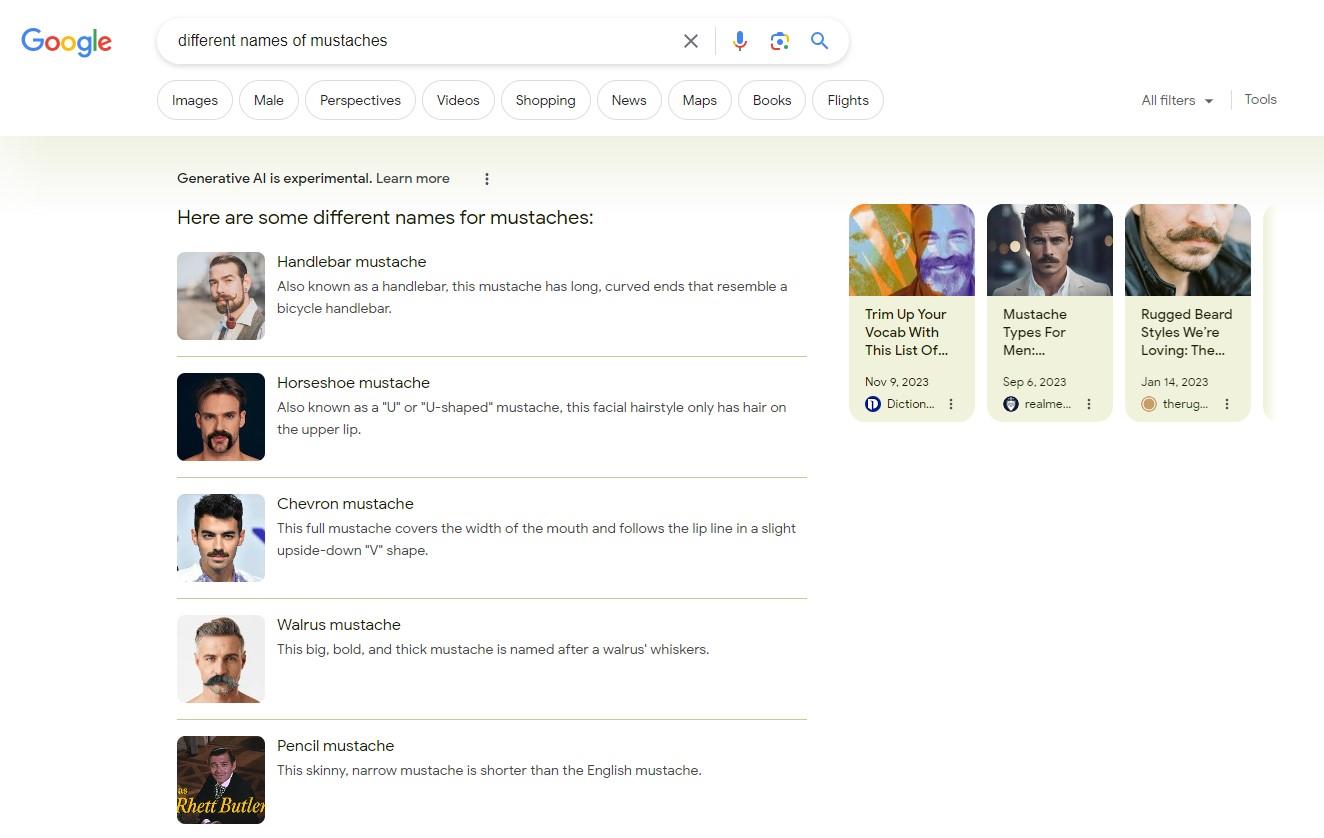
The places module is one of the most common SGE modules that people can encounter. According to research from Brightedge, more than a third of SGE results include AI-generated local packs as of January 2024. The SGE local module isn’t much different than the traditional local pack aside from a couple of notable features.
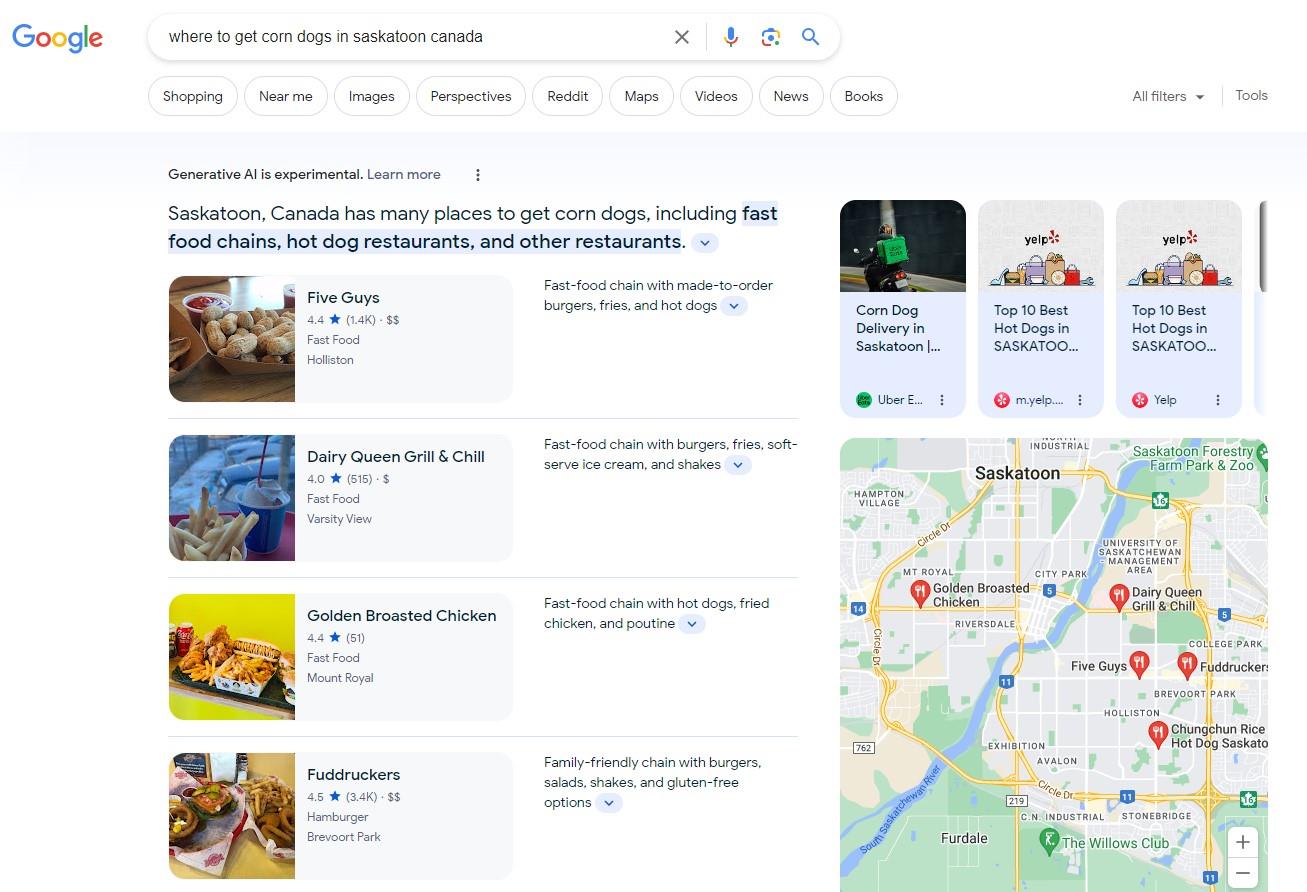
SGE offers a variety of different results types for product-based queries. These different results are tailored to giving clear pricing information, comparing products, and sharing trends. providing value with one of the following product modules:
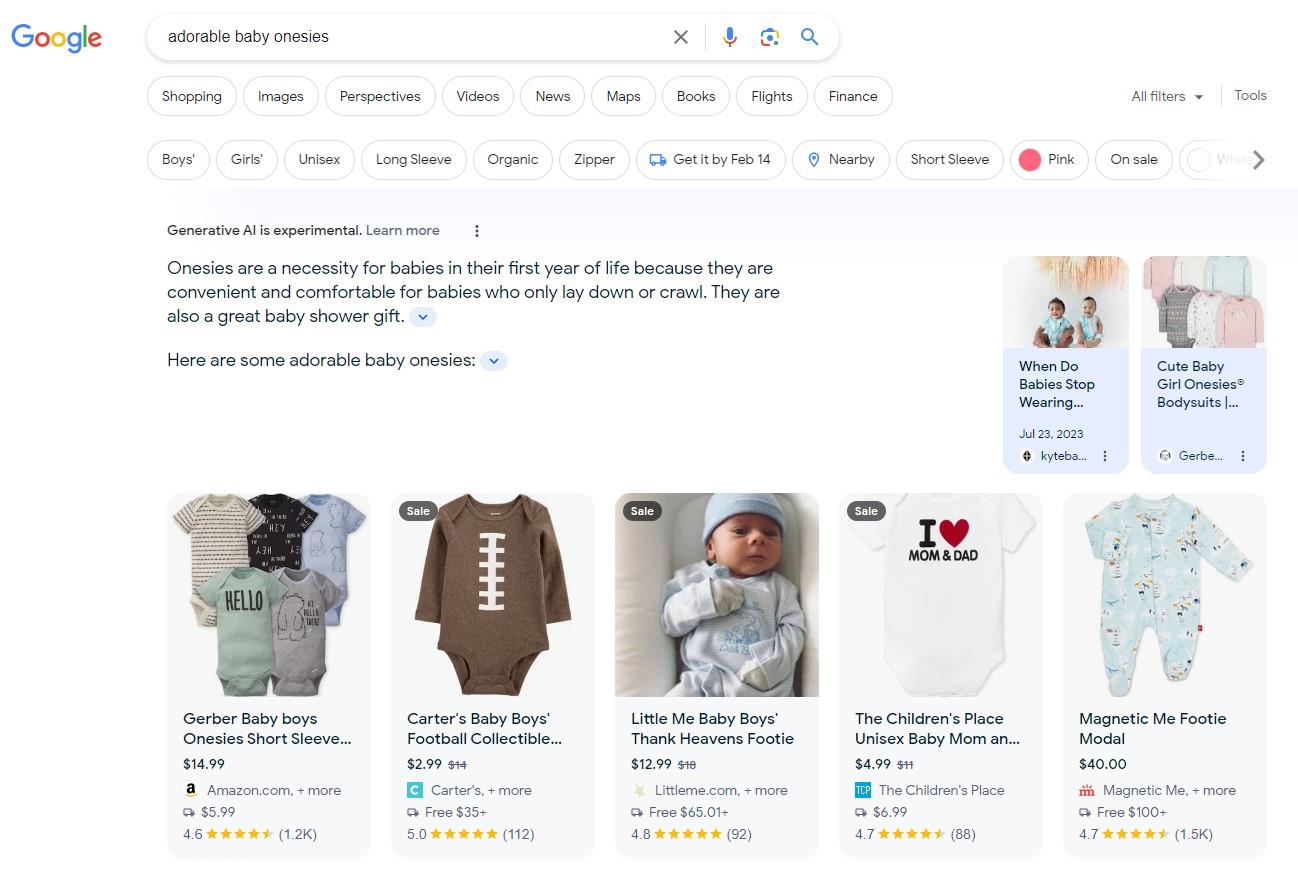
Despite how far AI tools have come, they’re not perfect. SGE has a variety of issues that it still needs to address before it can become a true part of the Google search experience.
A world of AI-driven Google search results isn’t quite as close as people may expect. SGE was supposed to expire as a Google Labs experiment at the end of 2023, but the timeline for it being a completed feature was quietly pushed back. Why the delay, you may ask? Here are a few good reasons according to Search Engine Journal:
Those are some serious problems when people want good, accurate information! A lot of new experiments have bumps in the road, but the potential for wrong info is a serious issue that can cause everything from small headaches and grumbles to serious issues for people believing that Google gave them legitimate information to address their problems.
Sometimes being wrong isn’t the only problem with Google results. Sometimes SGE delivers an experience that’s just… strange and unhelpful. Just take a look at this SGE results for the best drinks in Disney World for example.
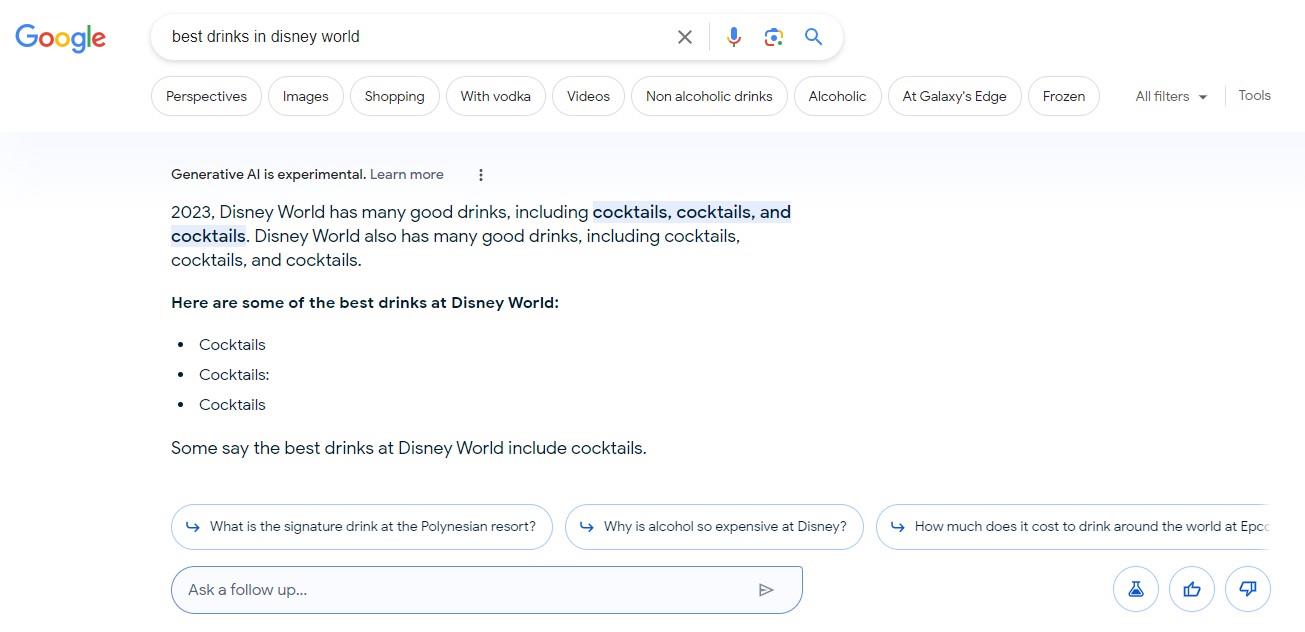
Unless you weren’t sure if Disney World had cocktails, this result doesn’t seem very helpful. Sometimes the robots don’t always do a great job (or seemingly had a few too many drinks of their own).
Some people are less excited about our eventual robot overlords than others. There are still a notable number of people who are skeptical if AI-driven results or simply don’t trust AI at all. Only 25% of people trust AI-powered search engines to avoid misinformation and just a third of people trust that the results they’ll receive are factual. Google may move forward with AI efforts, but that doesn’t mean that everyone will buy into using SGE.
Change is scary, especially when you grow comfortable with something. Google regularly makes algorithm updates, but those modifications pale in comparison to the potential massive overhaul that Google sees in SGE.
These ongoing changes to Google results can have a notable impact on your website’s performance and will likely force many marketers to modify their methods. If those prospects scare you, you’re not alone. The Atlantic, a publication that’s been around for more than 160 years, named Google’s adoption of generative AI as a significant threat to their business and the digital publishing industry as a whole.
It’s not just The Atlantic either – more than half of tracked news publications block AI bots according to Palewire. While the news industry is an extreme case, it’s safe to say that most websites will see bumps in the proverbial road.
If people won’t need to leave Google’s SGE for information, businesses can expect fewer clicks to their website. According to a study by Search Engine Land, the aggregate organic traffic drop caused by SGE ranged between 18-64%. There are a few different reasons why this drop may occur:
While some loss of clicks is to be expected, the exact amount can vary greatly based on industry, current content and SEO tactics, and the types of queries that drive a lot of your traffic. Some businesses won’t see much of a hit, while others may try to curse Google for its AI-driven ways.
While SGE is mostly going to affect organic traffic, there are some questions as to how changes in Google Search will affect digital advertising as well.
The good news for Google ads is that they aren’t buried on the SERPS with SGE overhaul. Ads are currently shown both above and below SGE results, but those exact placements may change as Google adds more features or makes new changes. Still, digital advertising experts have a few hunches around what marketers may expect once SGE is fully implemented.
Remember how some people are skeptical about Google SGE’s ability to provide consistent, factual information? Google is aware of the potential for misinformation and problematic results, which is why they’re particularly careful about “Your Money or Your Life” keywords.
If you’re not familiar with this dramatically named term, YMYL keywords refer to queries that relate to matters where accurate, trustworthy information is essential and can make a significant impact on users. YMYL generally includes the following types of topics:
Due to the sensitive nature of these topics, SGE prioritizes more proven sources that Google feels it can trust instead of pulling information from the average site. Those measures still can’t promise complete accuracy, so Google has added a variety of warnings to SGE results tailored to YMYL topics. These warnings are a safeguard to make it clear that SGE results are not professional or legal advice and recommending that people consult experts for official answers.

SGE is a major change, and that means it’s time to make some adjustments to your marketing strategy. To prepare your website for SGE, you’ll want to focus on not just appropriately adapting your content strategy, but also aligning the technical aspects of your site to the evolving landscape of Google search.
Content optimization will be the cornerstone of preparing your website for SGE, with the biggest focus on tone. You’ll want to review your current content approach and ask yourself, does this sound natural? Would someone actually say this? Since users are increasingly using voice queries to interact with search engines, you’ll want your content to align with how people actually speak to optimize for relevance and discoverability.
You’ll also want to evaluate your content structure and formatting. Do you use logical headers? Do you break down information into bullet points where appropriate? Are you utilizing structured data markups like schema? These tactics will both help with readability and make it easier for Google’s AI tools to understand the hierarchy and context of your information. That combination will make it more likely for your content to be pulled for rich snippets and SGE’s various modules.
When you address the informational needs of users at every stage of the buyer’s journey – from those just beginning to explore a product of service to those ready to make a purchase – you create a comprehensive online resource search engines can utilize in a variety of search queries.
Google’s algorithm rewards websites that offer diverse and valuable content across the digital marketing funnel, considering it a sign of authority and relevance. When you create blogs, videos, guides, and other forms of content for every type of prospect, you’re increasing the chances that your website will be featured in their search results, both SGE driven and not. This diversification of content is great for your SERP rankings and helps you cater to specific audience segments, capturing their interest and guiding them through their buyer’s journey.
SGE places a strong emphasis on providing users with trustworthy, authoritative information. When a business is recognized as reputable, Google is more likely to prioritize that website’s content. This trustworthiness could lead to an increase in your information getting pulled for AI-driven results along with featured snippets and knowledge panels.
To strengthen your online reputation, consider the following tactics:
You may have heard of the acronym E-A-T – expertise, authoritativeness, and trustworthiness – but Google has gone ahead and updated that, too. By introducing an additional E for experience, Google is letting us know that it's paying more attention to how much experience any given content creator may have on a particular subject.
Let’s breakdown the new and improved E-E-A-T concept and how it can help you optimize your site for both SGE and traditional search results:
Did you ever think that you should try expanding your brand’s reach to other platforms or channels? Now is a good time to do it.
While it can be hard to break the habit that Google is the organic overlord – and it still is very important – it’s not the only place people go for information. People under the age of 30 are more likely to use social media than Google Search when searching for info according to the Pew Research Center. Platforms like TikTok, Reddit, and even podcasts are increasingly popular destinations for users, and it may be time for your brand to expand its efforts accordingly.
Marketers aren’t the only people starting to notice this trend. Google SGE even uses TikTok videos as resources in featured snippets these days. While experts may debate over whether TikTok is a search engine, we can make a few clear conclusions:
Everything you’ve written on your website can and likely will be crawled and used at some point by SGE, ChatGPT, or some other AI tool. That reality means that the content you spent all that time and money on can be used to fuel their answers. However, there are options to prevent generative AI from crawling your content.
Several organizations have already taken steps to try and keep generative AI tools from accessing their websites. The number of websites blocking AI bots jumped by 180% from Oct. 8 to Nov. 19 2023, including major publications and brands like The New York Times and Condé Nast, with more expected to join over time.
The way to block AI bots like GPTBot, CCBot, and Google-Extended involves updating your robots.txt file. By taking the following steps, you can prevent those web crawlers from scraping your content.
It’s important to note that Google-Extended does not prevent SGE from crawling your site. Google has specifically stated that SGE is a key feature of Google Search, so it can still show results from your site even if you disallow Google-Extended in its robotos.txt file.
Despite the inclusion of SGE as a core part of Google Search, organizations set on blocking all AI crawls are not out of luck. Websites can still block Googlebot, the software Google uses to crawl sites for Google Search. The process of blocking Googlebot from accessing your website is the same steps as shown above, except for adding Googlebot as the user agent being disallowed.
While you certainly can prevent your site from being crawled, it doesn’t necessarily mean that you should. You’ll need to weigh the pros and cons of blocking generative AI tools from accessing your website. To start, here are some potential reasons why you would consider blocking AI bots from crawling your content.
That’s the good news! The bad news is that blocking AI bots like ChatGPT has a few drawbacks. The first is that if you don’t want ChatGPT to access your content, it lessens how helpful the tool can be for content generation. You won’t be able to use your content to try and have generative AI tools match your voice and style.
Another problem is that generative AI tools won’t show your business at all. These tools tend to give more educational answers anyway, but users who give hyper specific prompts like the following question won’t ever have a chance to see your brand.

Those are relatively minor issues, especially compared to what happens if you block Googlebot. If you choose to do that, your site won’t show up in Google Search. At all. That’s a severe consequence for any business relying on organic traffic and one that we wouldn’t recommend aside from hyper specific situations.
It’s not the only drawback either, as Search Engine Land’s technical SEO expert Kristina Azarenko found that blocking also tanked video search results as well. In short, stopping SGE from crawling your content is going to hurt so much that it’s better to play Google’s game than avoid it.
SGE is not a complete product quite yet, so there’s still plenty of changes that can (and probably will) affect your future tactics. Keep an eye out for any updates from Google – at some point our search overlords should announce a full release date along with their best practices for how businesses can navigate SGE going forward.
As for now, don’t panic. If you follow general best practices, create quality content, and mix in some of the tactics we recommended above, you can start preparing your website for an SGE-driven world.
Of course, it’s not easy doing all that work by yourself. Aztek offers businesses the expertise, resources, and a fresh perspective to help them bolster their marketing efforts. Reach out to us today to talk to one of our experts and see if we’re a good fit for your business.